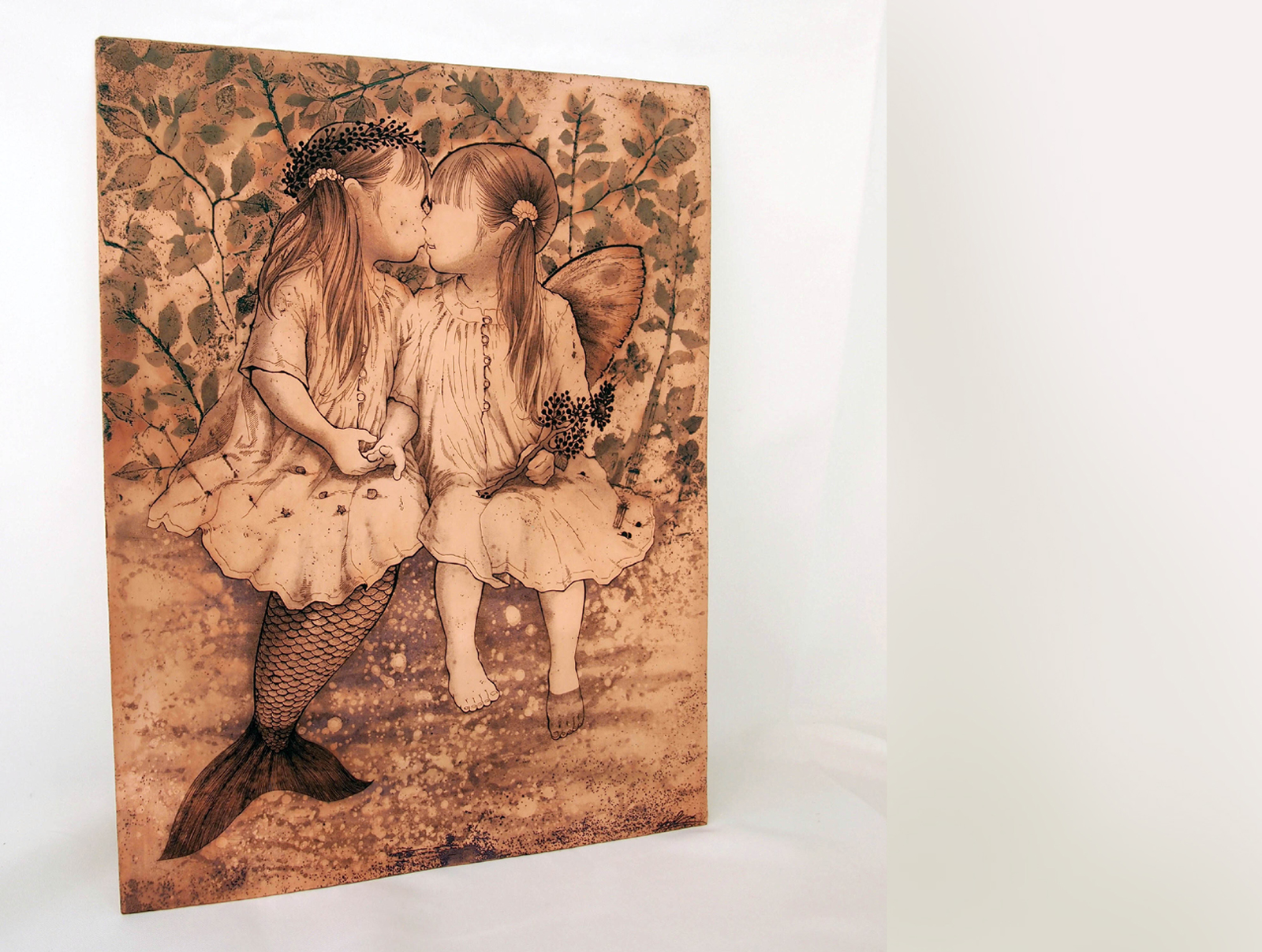
Interview with popular copperplate engraver, Yui Koyanagi. Please enjoy reading the second half of this interview by the FFD editorial team!
Interview with artist Yui Koyanagi (part 2)
The flightless butterfly flies
One recurring theme we see in your art is the “six-winged butterfly”. Whenever I see it, I wonder where the inspiration came from.
I created that out of my desire to describe what I was going through. I was frustrated not being able to become the woman, the person, and the artist I’d longed to be. The six-winged butterfly was born out of that internal conflict. The butterfly has such beautiful wings, but having too many wings can be a burden that prevents it from flying away. There’s a constant struggle between who others want me to be, who I want to be, and who I really am!
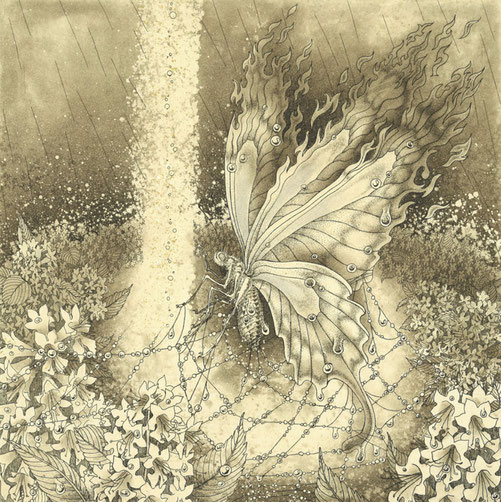
It was much later on that I began to have butterflies fly in my work, many years after I started drawing.
Why do you think the butterflies started to fly?
I think that once I learned to accept myself more openly and honestly for who I was, that’s when the butterflies took flight.
I presented my Rust Colored Forest Series, a series of ten copperplate prints of butterflies in a solo exhibition in 2017. In that series, a butterfly that couldn’t fly burns its wings to exhaustion. Burning, like for the phoenix, is a symbol of immortality. It illustrates abandoning our old values and reexamining our core selves. If we can’t fly, we can simply move to an environment where it’s possible to fly, or we can create a place where we wouldn’t need to fly.
That’s when I realized I could finally accept myself as I was, and oddly enough, I found myself wanting to paint butterflies in flight!
What made you change your mind?
The biggest reason was going through pregnancy and childbirth. Welcoming my children into this world with their own unique personalities and watching them grow up at their own pace made me realize that the most important thing is for everyone to have a comfortable place to live. Then the six-winged butterfly and my own internal struggles seemed more endearing.
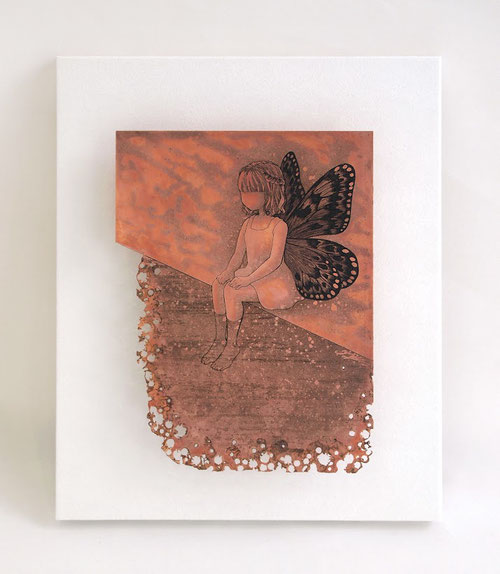
Shrubs – From the thorns to its fruits
The duo exhibition happening at the Isetan Shinjuku flagship store on Dec 28th, 2022 is very unique. The exhibition is called “cusp”, named for a pointed tip, the point where two curves meet, where one constellation ends and the next one begins.
That’s right! During our meeting, the word “cusp” was reminiscent of the thorns of a shrub. These thorns play an important role to support the young branches by leaning themselves on the surrounding trees. However, once the shrub matures into small trees, the thorns are no longer needed for support, and the thorns come off. The grown tree bequeaths its fruits to the next generation; the cycle is suggestive of life itself.
It’s similar to my philosophy as well; “Creating in the process of living and decaying”. The thorns decay while carrying out its role of supporting young branches, and when it eventually falls off, it bears fruit.
What’s my role for the children? I created the copper relief engraving gift, reflecting on the thorn and fruit bearing shrubs.
I can’t see the mermaid, but I can see the waves that form
There are issues in our society before they become social issues — before they’re given a name and before others know the issues exist. You’ve created several of your works on these themes. How were you able to create these works?
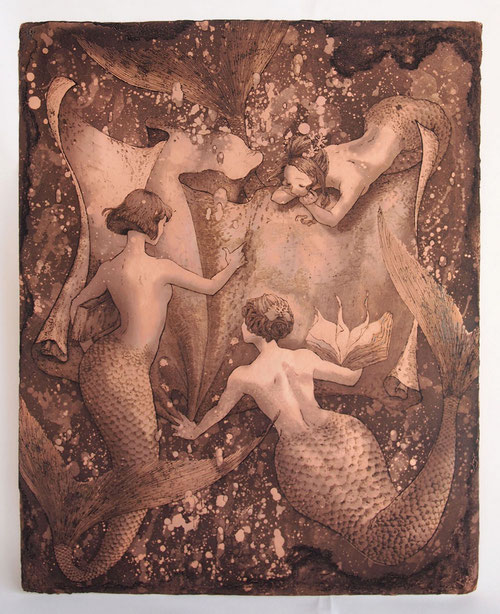
Being unaware of something right in front of you for a long time because you simply weren’t paying attention to it happens very often. Some people refuse to look at things that are inconvenient for them, or they might be indifferent towards things that don’t interest or harm them. I think the world is full of such experiences.
Just recently, a new social issue came to light, the club activity issue at schools.
Ah, yes. My friend from college is a school teacher, and the club activity issue has been a frequent topic of conversation with our group of friends.
A friend who majored in art became an art teacher, but was put in charge of an athletic club activity because she was young, and had to lead practice games even on holidays. The young teachers have no say in the matter and get frustrated. Some decline the role altogether, but there’s usually no choice; others are antagonistic towards those who decline.
I didn’t even know such a problem existed, much less whether the club activity issue was the name for it.
The first to speak out were just a few people. In the eye of society, it was just a small noise, a blip.
Which has evolved into a huge predicament and is now acknowledged as a social problem.
That’s right. People who sympathized with the issue came to help and collaborated on many levels.
To put it in a different way, presenting new societal values means that one has to go out of one’s way to make a splash in order to be seen and acknowledged. For example, women’s suffrage was a presentation of new societal values. It became a big enough whirlpool of an issue that brought about change in the tide of society. As a society, we will continue to change and evolve for the better, building a better world that’s easier for our children to live in.
In the work Uzushio wo Okoshini (To Wake the Whirlpool), the mermaids are depicted trying to independently decide their course of action, holding a nautical chart in their hands. Mermaids are a symbol, so to speak, of “if you don’t know about it, it doesn’t exist”. The mermaids’ strong driving force creates a swirling tide that finally makes their existence known to society. People above ground can’t see what’s beneath the ocean surface, and they only become aware once the waves swell and grow.
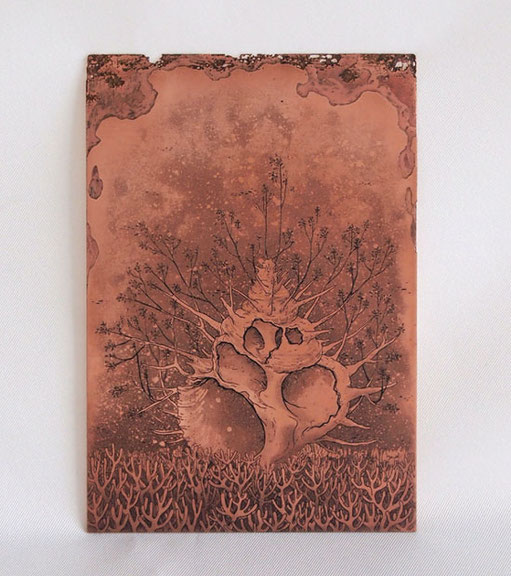
In your work, we see the bubbles in the water.
Yes, the water and the bubbles are a symbol of life.
In 2022, artists speak out to convey their messages
Your recent work is one not to be missed. In this era, we need to send out a message from Japan. Can you please speak a little more about this work?
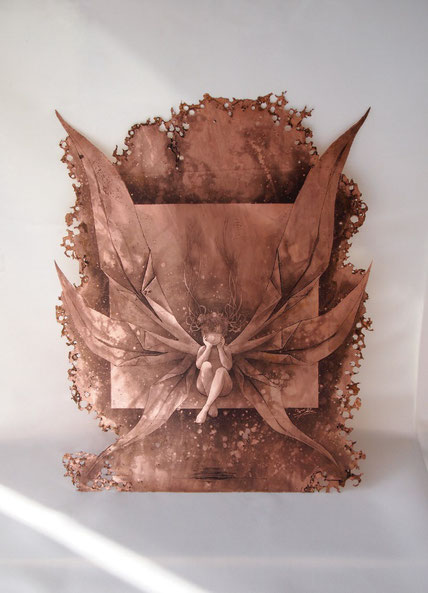
2022 was a year when I thought hard about what we can do as Japanese people. In this piece, I made a drawing of folded origami crane wings to convey a simple message to people worldwide. Origami cranes are symbols of prayers for Japanese people. The child in the center is a symbol of hope for the future. I entrusted my prayer for peace for the world through the child placed in the center of the many origami cranes.
Situations will continue to change in international affairs. I believe that we need more opportunities to communicate about the work of our eras’ artists.
I also hope that our children will move forward towards a world without war, killing and divisiveness.
Thank you very much for your time today.
(interviewer, FFD editorial team)
Yui Koyanagi, Artist bio and exhibitions
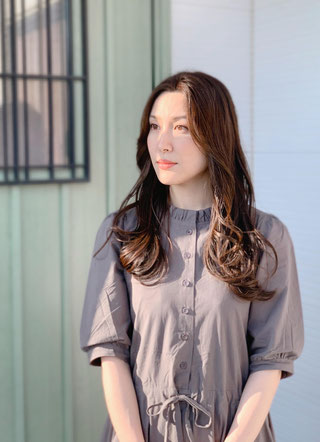
Bio
Born in Kitakyushu City, Fukuoka
Graduated from Jiyugaoka High School
Graduated from Orio Art Institute
Graduated from University of Tsukuba, Fine Arts, Special Curriculum, Printmaking
Exhibitions
2022 Solo Exhibition, Yui Koyanagi, Etched Copper Art, Their Place, Ginza Mitsukoshi
Kobe Art Festa 2022, Kobe Meriken Park Oriental Hotel
2021 Solo Exhibition, OTO gallery
Solo Exhibition, Uroko no Uta (Song of Scales), Fukufukudo @Hilltopia Art Square
2019 Solo Exhibition, Chou no Shizuku (Butterfly Drips), Ginza MItsukoshi
Solo Exhibition, THE LIGHT, FCA
Gakuenmae Art Festa, Nara City Gakuenmae area
THE LIGHT, FUJIMURA CONTEMPORARY ART, Yokohama
2017 Solo Exhibition, Sabi Iro no Mori (Rust Colored Forest), FCA
2016 GINZA ART FESTA, Matsuya Ginza
Until the time is filled, Nagano Tokyu, Nagano
2015 ART OSAKA 2015, Hotel Granvia Osaka
Solo Exhibition, Yui Koyanagi Etched Copperplate Prints and Oil Paintings, Abeno Harukas
Original Drawing Calendar Exhibition, Kokoro Kokoni Koyomi to Tomoni, Ginza Itoya, K. Itoya
2014 Art Debutante URAWA footprints, Isetan Urawa
2013 Solo Exhibition, Fleurir!, OTO gallery
Solo Exhibition, Gene Note, Isetan Shinjuku Main Building
Solo Exhibition, New Melody, Gallery Uehara
2012 Shugyoku no Josei Artist Exhibition (Gem of Female Artists), Ginza Mitsukoshi
lllline@shigagin Shiga Bank, Nagahama North Branch
lllline, Gallery Uehara, Tokyo
Solo Exhibition, Shigure Chou (Autumn Rain Butterfly), Isetan Urawa Store
2011 The traces of corrosion, Gallery Uehara, Tokyo
International Art Expo New York 2011, Pier94, New York
2010 TRIUMPHAL ARCH, la fontaine, Fukuoka
Description of Yui Koyanagi’s work, gift
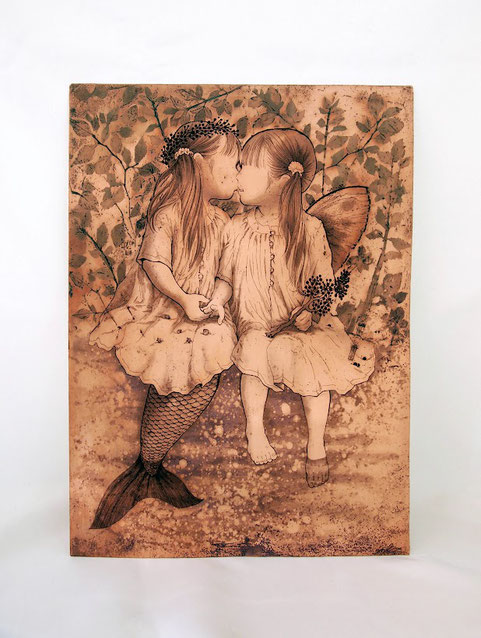
Girls are depicted in this etching. If they were in school, they would be classmates. Their hairstyles and the clothes they’re wearing are similar, but one is a mermaid and the other a winged fairy.
Since childhood, there are aspects of our being that were instilled to be standardized, and other parts that aspire to be standardized. We all have different characteristics, even though we seem to exist in harmony.
By keeping the drawing faceless, the artist gives the viewers a chance to replace the girls with “us”, the viewers themselves, which adds a sense of universality to the piece.
We may look similar, but we each have different characteristics. Mermaids prefer the water, and fairies, the forest.
What’s the “harmony” between not only the visible, but also the invisible?
Achieving harmony through logical discourse and mutual understanding is one way, though challenging. Yet, we realize that logical means of diplomacy alone are not enough.
This piece of work, gift, is the artist’s answer to the question looking for other means to achieve harmony.
Gift = a present. A gift is also a symbol of selfless love.
We see wild thorn shrubs In the background. The thorns hurt those nearby, but they also support the growing young branches. It’s a life cycle that evokes love and life.
– Here’s a fruit from the shrub.
– Here’s an Akoya fruit.
We are alike, and yet we are also different.
Artists think through their works in relation to society. They offer values through their works. That’s why it’s interesting to see works created by artists who live in the same era.
In this piece, the background is equally divided into a forest in the upper half and the sea in the lower half. The two girls are sitting on the border.
The fairy has one foot in the water, so as not to put too much emphasis towards the upper part of the piece. The mermaid’s tail is drawn in strong contrast, bringing stability to the lower part of the piece. The artist’s profound technique brings a delightful harmony to this complex composition.
(description by FFD)
Details of Yui Koyanagi’s exhibition
Coming soon.